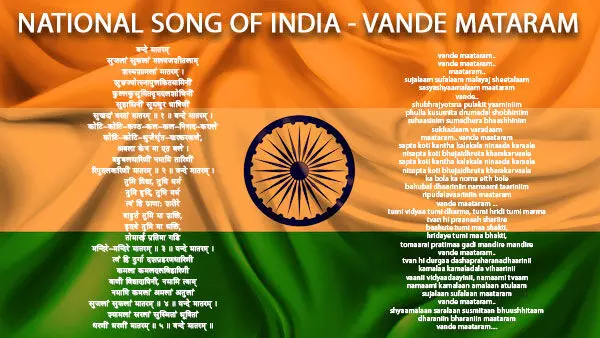National Song of India: Vande Mataram Lyrics, History & Significance
Explore Vande Mataram, India’s National Song — its lyrics, history, meaning, and 150-year celebration inaugurated by PM Modi in November 2025.
National Song of India: Vande Mataram Lyrics, History & Significance

The National Song of India, Vande Mataram, is more than a patriotic hymn — it is a timeless expression of India’s unity, freedom, and devotion to the motherland. Written by Bankim Chandra Chattopadhyay in 1875, this powerful composition inspired generations during India’s independence movement and continues to echo in national ceremonies even today.
Why in News? – 150 Years of Vande Mataram
Prime Minister Narendra Modi inaugurated the 150-year celebration of India’s National Song “Vande Mataram” on November 7, 2025, at the Indira Gandhi Indoor Stadium, New Delhi.
Written on Akshaya Navami (1875), the event marks a year-long commemoration with:
🇮🇳 Mass singing of the full version nationwide at 9:50 AM
🪙 Release of a commemorative coin and postal stamp
📅 Celebrations continuing until November 7, 2026, across India
What Is the National Song of India?
The National Song serves as a symbol of national pride, cultural identity, and unity.
Vande Mataram — composed in a mix of Sanskrit and Bengali — expresses love and reverence for the motherland, representing India’s spiritual and linguistic diversity.
Historical Background of “Vande Mataram”
Year Event
1875 Bankim Chandra Chattopadhyay wrote Vande Mataram on Akshaya Navami.
1882 The poem was included in his novel Anandamath.
1896 First sung publicly at the Indian National Congress session.
1905 Became a rallying cry during the Swadeshi Movement.
1950 Adopted as India’s National Song by the Constituent Assembly on 24 January.
2025–26 150-year celebration across India.
Lyrics of the National Song of India
“Vande Mataram!”
Mother, I bow to thee!
Sujalam suphalam malayaja shitalam,
Shasyashyamalam Mataram!
Shubhrajyotsna pulakitayaminim,
Phullakusumita drumadala shobhinim,
Suhasinim sumadhura bhashinim,
Sukhadam varadam Mataram!
Vande Mataram! Vande Mataram!
➡️ The refrain “Vande Mataram” means “I bow to thee, Mother”, symbolizing reverence and devotion toward the nation.
Vande Mataram During the Freedom Struggle
Became a rallying cry for independence, especially during the Swadeshi Movement.
The British government banned its public singing in Bengal, further fueling its significance.
Freedom fighters like Shirish Kumar and Babu Genu embraced it as a cry for liberty.
It united Indians across faiths and regions in the common cause of freedom.
Significance of Vande Mataram Today
Even today, Vande Mataram is sung at schools, national ceremonies, and cultural events. It remains:
A symbol of patriotism and collective identity.
A tribute to India’s cultural and linguistic diversity.
A reminder of sacrifice and selfless service.
A representation of unity in diversity and India’s enduring spirit.
While the Constitution does not explicitly define a “national song,” the Government of India accords Vande Mataram equal respect to the National Anthem.
Code of Conduct
Unlike the National Anthem (which has legal status under the Prevention of Insults to National Honour Act, 1971), Vande Mataram does not have formal guidelines.
However, it enjoys equal dignity and moral reverence, as emphasized by President Rajendra Prasad at the time of adoption.
Relevance for UPSC and Students
For UPSC and general studies aspirants, Vande Mataram represents a key cultural and historical symbol:
Reflects India’s freedom struggle and unity.
Part of Indian Heritage, Modern History, and Polity (National Symbols).
Frequently appears in UPSC Prelims & Essay topics on nationalism and cultural identity.
Conclusion
Vande Mataram isn’t just a song — it’s the heartbeat of India’s national spirit.
From the freedom struggle to modern India’s milestones, its verses continue to inspire pride, unity, and service toward the nation.

